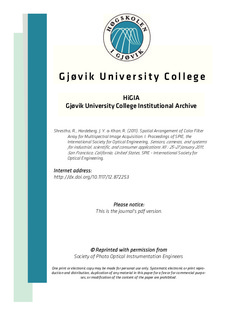| dc.contributor.author | Shrestha, Raju | |
| dc.contributor.author | Hardeberg, Jon Yngve | |
| dc.contributor.author | Khan, Rahat | |
| dc.date.accessioned | 2011-04-18T08:13:00Z | |
| dc.date.available | 2011-04-18T08:13:00Z | |
| dc.date.issued | 2011 | |
| dc.identifier.citation | Shrestha, R., Hardeberg, J. Y. & Khan, R. (2011). Spatial Arrangement of Color Filter Array for Multispectral Image Acquisition. I: Proceedings of SPIE, the International Society for Optical Engineering, Sensors, cameras, and systems for industrial, scientific, and consumer applications XII : 25-27 January 2011, San Francisco, California, United States, SPIE - International Society for Optical Engineering. | en_US |
| dc.identifier.isbn | 9780819484123 | en_US |
| dc.identifier.issn | 0277-786X | |
| dc.identifier.uri | http://hdl.handle.net/11250/142520 | |
| dc.description | This is the copy of journal's version originally published in Proc. SPIE 7875: http://spie.org/x10.xml?WT.svl=tn7. Reprinted with permission of SPIE. | en_US |
| dc.description.abstract | In the past few years there has been a significant volume of research work carried out in the field of multispectral image acquisition. The focus of most of these has been to facilitate a type of multispectral image acquisition systems that usually requires multiple subsequent shots (e.g. systems based on filter wheels, liquid crystal tunable filters, or active lighting). Recently, an alternative approach for one-shot multispectral image acquisition has been proposed; based on an extension of the color filter array (CFA) standard to produce more than three channels. We can thus introduce the concept of multispectral color filter array (MCFA). But this field has not been much explored, particularly little focus has been given in developing systems which focuses on the reconstruction of scene spectral reflectance. In this paper, we have explored how the spatial arrangement of multispectral color filter array affects the acquisition accuracy with the construction of MCFAs of different sizes. We have simulated acquisitions of several spectral scenes using different number of filters/channels, and compared the results with those obtained by the conventional regular MCFA arrangement, evaluating the precision of the reconstructed scene spectral reflectance in terms of spectral RMS error, and colorimetric ▵E*ab color differences. It has been found that the precision and the the quality of the reconstructed images are significantly influenced by the spatial arrangement of the MCFA and the effect will be more and more prominent with the increase in the number of channels. We believe that MCFA-based systems can be a viable alternative for affordable acquisition of multispectral color images, in particular for applications where spatial resolution can be traded off for spectral resolution. We have shown that the spatial arrangement of the array is an important design issue. | en_US |
| dc.language.iso | eng | en_US |
| dc.publisher | Society of Photo Optical Instrumentation Engineers (SPIE) | en_US |
| dc.relation.ispartofseries | Proceedings of SPIE;7875 | |
| dc.title | Spatial Arrangement of Color Filter Array for Multispectral Image Acquisition | en_US |
| dc.type | Journal article | en_US |
| dc.type | Peer reviewed | en_US |
| dc.subject.nsi | VDP::Mathematics and natural science: 400::Information and communication science: 420::Simulation, visualization, signal processing, image processing: 429 | en_US |
| dc.source.pagenumber | 9 | en_US |
| dc.identifier.doi | http://dx.doi.org/10.1117/12.872253 | en_US |
